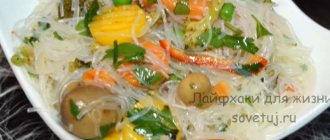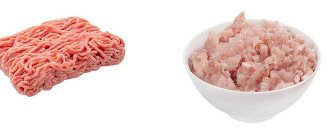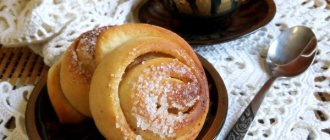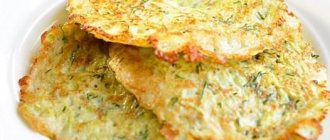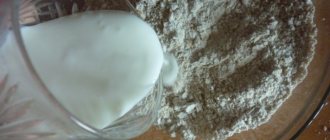People who have been on diets for a long time and are overweight dream of always eating to their fill, but not gaining weight.
Is something like this possible? The Japanese claim that there is nothing special about this way of eating and have been using it for many centuries. In the Land of the Rising Sun, a common plant called konnyaku is used as food. In European style, it can be called “snake palm” or “devil’s tongue,” which was given to it due to the strange appearance of its flower. It can really scare an unprepared person. However, there is nothing dangerous or scary about this plant. Many dishes are prepared from it, including shirataki noodles, and we will tell you what it is and what it is eaten with in our article.
Japanese shirataki noodles: features and nuances of the product
The konjac plant has been cultivated for many centuries in Japan, China, Indonesia and throughout the Southeast of the Asian continent. It grows on high mountain slopes. There, the air and soil are not yet contaminated with human waste products or toxins. Therefore, you can harvest high yields of an environmentally friendly product. In traditional Japanese farming, the roots of the plant are used, which are not only eaten. It is flattened, then boiled, stewed, used to make special cosmetic sponges for washing and ground into flour. Various semi-finished products are subsequently prepared from it, including shirataki noodles.
From root vegetables to spaghetti
Despite the exotic appearance of konnyaku inflorescences (photo above), you should not be afraid of it.
The food is eaten as a root vegetable that resembles a large beet or turnip. The tuber is slightly flattened and has a tough, fibrous skin. It can be eaten raw, but also processed, canned and even stored in the cellar, like regular potatoes. One such “root” can reach three and a half or four kilograms. Most often, Japanese farmers dry konnyaku tubers in the open air and then grind them into powder. This is how shirataki flour is obtained here, from which noodles are then made, which became very popular in Europe after the recommendation of Dr. Dukan, a famous specialist in healthy nutrition. These noodles allow you to “put off” the feeling of hunger for a long time, without gaining a single kilogram. This is especially important for those who are watching their figure or struggling with excess body weight.
Nutritional value, composition and calorie content of Japanese noodles
This product is considered traditional for Japanese cuisine. It is almost as popular as rice in popularity and prevalence. It is used not only for making noodles, but also as thickeners and for gelling. The noodles themselves qualitatively absorb the taste, aroma, all the subtleties and nuances of sauces and seasonings served with it. In appearance, it resembles rice vermicelli, is also slightly transparent, and the word shirataki itself means “white waterfall.” These noodles have almost no taste of their own, but they do have a characteristic smell that not everyone likes. True, it can be easily eliminated during the cooking process.
Japanese noodles contain only two components: water (96–98%) and dried konnyaku root (2.8–3.5%). Some mass producers add a little salt for taste, but true traditional recipes do not contain it.
The nutritional value of the product is amazing - it is one of the lowest calorie foods in the world. One hundred grams of noodles contain only zero to nine calories. Probably only clean water can be less nutritious. For comparison, we can cite a green apple, which is twelve times more nutritious and is considered a dietary product. Today's best offers:
In fairness, it must be added that not only are there no calories in the pasta, the composition of shirataki noodles surprises even outstanding biochemists. It does not contain fats, proteins, vitamins, minerals and trace elements. The only exception is iron, of which one serving of such paste can contain from 5 to 8 percent of the daily value for an adult. The composition contains some fiber, as well as a tiny amount of special carbohydrates (glucomannan), up to 2.3 grams per hundred. They definitely won’t be able to have a detrimental effect on your figure.
The fiber from snake palm is special and is called the “broom of the body.” It has incomparable hygroscopic qualities. This is an insoluble substance. Once in the stomach, it swells, absorbing all excess: toxins, undigested fats, cholesterol, glucose. The substance itself is not processed by the body and is therefore excreted. Along with all the unnecessary “garbage”. What is also especially important is that the glycemic index of such pasta is zero.
What is the difference between shirataki noodles and funchose?
Many people believe that these products are identical.
They are mistaken because their raw materials, properties and features are completely different. Unlike shirataki, funchose is prepared mainly from the starch of legumes or other crops. Moreover, its calorie content cannot be compared with the fruits of the “devil’s tongue.” It is 265–325 kilocalories per hundred grams. That is, such a product for losing weight is seriously inferior to Japanese noodles in terms of nutritional level. However, the mineral composition of funchose is much more diverse. Saturated and unsaturated fatty acids, vitamins A, E, B (1–6, 9), PP. It contains selenium, calcium, zinc, copper, potassium, magnesium, iron, sodium, manganese, phosphorus and much more.
If on the shelf you see Frenchose of an excessively snow-white, almost transparent color, like shirataki, and it contains corn starch, then it is better to refuse to purchase such a product. To purify starch, which has a milky tint, harmful substances such as lead, aluminum and other metals are often used. This can lead to serious poisoning and subsequently cause chronic incurable diseases.
What is rice flour
The product of milling rice grains is the result of processing natural raw materials using simple technology. The ancient agricultural crop is considered a storehouse of useful elements (complex carbohydrates, minerals, vitamins), and the high level of starch content in the absence of gluten makes rice a dietary product. A hypoallergenic product that does not contain gluten, it is used in production as a thickener, in cooking - for baking and dietary dishes.
How to make rice flour at home
There will be no particular difficulties in preparing a dietary product at home. There are two ways to make flour from rice grains, which can then be used for various recipes for delicious dishes. As a result of the use of technologies, the grind will turn out to be finer or coarser, and you cannot do without using a blender, coffee grinder with a powerful chopper or a meat grinder:
- Dry technology is the simplest method, which involves grinding the rice in a blender or grinding with the help of another kitchen assistant.
- Wet technology is a more labor-intensive process, but it turns out to make a complete dietary product. The grains must be washed, soaked in warm water for 3-5 hours, and drained. Spread in an even layer on a towel, dry, then grind to the desired grind.
Useful properties of noodles
The beneficial effects of the konjac plant have long been known to people of science. It has been widely researched and proven. Therefore, there is no reason to doubt the benefits of the product made from it.
Advantages
Reviews about shirataki noodles are mostly positive. So what effect does it have on the human body? Should we pay attention to a new product for us and choose it, abandoning the more familiar rice noodles?
- Significant reduction in the level of “bad” cholesterol.
- Reduced hunger while dieting.
- Improving digestion and accelerating metabolism.
- Normalization of the functioning of all gastrointestinal organs, increased intestinal motility.
- Removing toxins and waste from the body.
- Normalization of blood sugar levels.
All this means that Japanese noodles are allowed not only for athletes, bodybuilders watching their weight, but also for people suffering from serious illnesses such as diabetes. There are many allergy sufferers, but they can also eat these noodles. After all, it does not contain not only active allergens, but even gluten.
The use of shirataki noodles in the Dukan protein diet
After oat bran, a new type of noodle for us has become one of the cornerstones of the Dukan diet. The first stage in it is called an attack, that is, it is designed not only to help a person lose extra pounds, but also to change your entire understanding of food in general. Noodles are included in the list of the most satiating, low-calorie foods that can be eaten at any time of the day, in any quantity.
The benefits of noodles, which can be consumed without restrictions, were calculated by the famous Frenchman Pierre Dukan himself. In two thousand and eleven, he included it in the list of hundreds of products that are not harmful to the body and figure. At the same time, you can buy such pasta anywhere, even at the nearest Auchan supermarket; the main thing is to carefully monitor the composition.
Rice noodles
The mineral composition of rice noodles contains iron, calcium, sodium and potassium. This type of noodle is an excellent alternative for those who are allergic to the gluten found in noodles made from wheat flour. Typically, rice noodles are made from brown rice, which contains more nutrients and fiber that improve the functioning of the gastrointestinal tract. The calorie content of noodles in this case is even less. Rice noodles have a neutral taste, so you can use spices to add unique flavor combinations to the dish. It can be eaten with tomato sauce, legumes and various vegetables.
How to cook and serve
Cooking noodles is slightly different from the usual cooking of noodles, even if we are talking about rice or any other kind.
There are special rules and procedures that will allow the preliminary preparation to be carried out correctly. It’s not enough to just take out the pasta and throw it into the water - you definitely won’t be able to get a tasty and healthy dish. Let's figure out together how to cook shirataki, what you need to know, be able to do and how to serve the product. Opening a package of konnyaku pasta reveals that it has a strong unpleasant odor. Don't worry about this as it is not an indicator of quality. The aroma will completely disappear during the cooking process, so just ignore it.
Boiled
- Remove the top package without special precautions; most often there is another one inside.
- Most often the bags will have instructions on how and where to open them, but you can simply cut the plastic off with kitchen scissors.
- There may be some liquid inside the bag - this is normal. It will have to be drained.
- Shirataki vermicelli must be rinsed for some time under running cold water. The Japanese recommend keeping it in a colander under the tap for two to three minutes, stirring lightly with your hands or a spoon.
- Boil water, salt it if necessary, and then throw the noodles into the ready-made boiling water.
- You need to cook the noodles for two or three minutes, some recommend increasing this time to five. It is very important not to overcook the product, otherwise it may not be chewable at all. Its qualities will not suffer at all.
- Place the noodles in a colander and let all the liquid drain. No need to rinse.
Fried
- Remove the pasta from the bag and rinse in the same way as in the first cooking method.
- Place a frying pan on the fire (preferably made of cast iron), pour a little vegetable oil into it. Heat until a drop of water dropped into it sizzles loudly.
- Place the noodles in the pan and fry for one minute, turning them constantly.
- When all the liquid from the product has evaporated and the vermicelli itself becomes dry, the process is complete - it can be served.
*You don't need to cook this type of noodles for too long. This can cause it to become rubbery or oaky, making it impossible to eat.
Shirataki can be served as an addition to other dishes, or vice versa - as the main ingredient, to which various products are already added. She picks up smells and tastes well, for which she is especially appreciated by chefs. These noodles can be used in recipes that call for regular pasta, pasta or noodles made from wheat or other flour.
Calorie content of noodles and methods of its preparation
Today, there is a widespread opinion among nutritionists that the negative attitude towards noodles is unfounded. The calorie content of noodles primarily depends on what sauces are used as flavoring additions to the main dish. Often, noodles are served with side dishes of stewed or fried meat with gravy, which significantly increases its calorie content.
As you know, the calorie content of dry noodles ranges from 330 to 350 kcal. Of course, this product cannot be called dietary, but at the same time, it must be taken into account that there are significantly fewer calories in heat-treated noodles .
Dishes based on noodles do not pose a great danger to the figure. For example, the calorie content of noodle soup is low: only 80 kcal per 100 grams.
Today, Asian cuisine, in particular funchose noodles, is popular. The average calorie content of such noodles is 350 kcal per 100 grams. This amount of calories is explained by the fact that the dish contains vegetable oil.
Chicken noodles are pasta cooked in chicken broth. The calorie content of chicken noodles per 100 grams is 50 kcal. You can include this dish in your diet menu - it will not become an obstacle in the fight against excess kilograms.
Dish recipes
Recipes for shirataki are so varied that it would be impossible to cover them all in one article. Let's present a few to get a general idea of how to properly prepare such noodles and what they can be used with.
With spinach from Elena Kovach
The total nutritional value of a serving of this dish is 218 kilocalories. One hundred grams contains eight grams of protein, thirteen grams of fat and seventeen grams of carbohydrates.
Ingredients
- Shirataki noodles – 1 package.
- Onion (medium size) – 2 pieces.
- Garlic – 1–2 cloves.
- Chili pepper – 1 piece.
- Tomato juice – 50 grams.
- Fresh spinach greens - 2 bunches.
- Walnuts, ground – 1 handful.
- Pomegranate sauce – 1 teaspoon.
- Soy sauce – 3 tablespoons.
Cooking method
Rinse the vermicelli as in the tips above, wash the spinach under running water, and peel the onion from the husks and skin. Cut the onion into half rings, chop the pepper, chop the garlic into small pieces. Place the frying pan on the heat, add a little oil and sauté the onion first until it becomes translucent. Then add pepper and garlic there. Stirring constantly, fry for one minute. Add tomato juice and both sauces to the resulting mixture. Bring until thickened (1-2 minutes).
Spinach can be roughly chopped, but it is better to tear it into fairly large pieces with your hands. Place them in a frying pan, on top of the fried onions, in an even layer. After steaming for a few seconds, stir our dish and fry, constantly turning over for a few more minutes. Add pre-washed and steamed shirataki. Place the mixed product on a plate and sprinkle generously with chopped nuts.
Shirataki recipe according to Dukan
Preparing this dish with three types of peppers will take only fifteen minutes in total. It refers to sweet Bulgarian chili, not hot chili.
Ingredients
- Shirataki noodles – 2 packs.
- Red pepper – 1 piece.
- Green pepper – 1 piece.
- Yellow pepper – 1 piece.
- Medium tomatoes - 4 pieces.
- Wine vinegar - 3 tablespoons.
- Dukan salad sauce – 3 tablespoons.
- Garlic – 1 head.
- Parsley - to taste.
- Cayenne hot pepper - half a pinch.
- Salt - to taste.
Cooking method
Rinse the noodles and boil as usual. Remove the skins from the tomatoes and cut into cubes. Chop the peppers into small strips or into squares. Finely chop the garlic with a knife and chop the parsley to your liking.
Mix all the vegetables in a bowl, add sauces and vinegar. Add all the seasonings and spices there. Mix all this thoroughly with your hands or a spoon. Add salt. Pour the chilled noodles into a container, mix and place everything in a cool place. This dish is served unheated.
Fettuccine shirataki with chicken sauce
This name is given to shiritaki in the form of noodles - long, wide ribbons. Their composition is exactly the same as that of ordinary noodles, but they look much more appetizing and attractive in some dishes.
Ingredients
- Shirataki FettucineVeganprod or other similar – 1 package.
- Skinless chicken breasts – 2 pieces.
- Mushrooms (oyster mushrooms, champignons) – 250 grams.
- Cream (10%) – 1 cup (200 grams).
- Butter (preferably melted Ghee) – 30 grams.
- Grated Parmesan - 20–30 grams.
- Salt – 1 teaspoon.
- Pepper - to taste.
Cooking method
Rinse the vermicelli and boil as usual. Rinse the chicken breast under running water and cut into cubes. Finely chop the mushrooms with a knife and grate the cheese on a fine grater. In a large, thick-bottomed frying pan, melt the butter and add the garlic. After sautéing for a few minutes, add the chicken cubes and mushrooms.
Simmer it all, stirring constantly, for five to fifteen minutes. You want the meat to be completely cooked and not oozing. Add the cream, season with pepper and salt, stir and cook until the dish thickens. Place fettuccine on a plate, sprinkle with grated cheese, garnish with herbs and serve. It is customary to eat it hot, but if it has cooled down, you can reheat it in a frying pan or in the microwave.
How to cook "Mushroom noodles"
Cut the potatoes into cubes, and the champignons into medium pieces.
Finely chop the onion.
Pour 2 liters of water into a saucepan, bring it to a boil and add potatoes and mushrooms. After salting, cook covered for 20 minutes.
Fry the onion in vegetable oil until transparent.
Add mushrooms and fry along with onions for 20 minutes over low heat.
Add fried mushrooms to the potatoes and bring the soup to a boil.
Add noodles to the soup and cook until tender, 5-7 minutes.
Taste the soup for salt and add spices if necessary. The finished soup should sit covered for 20 minutes.
Bon appetit!
Harm and side effects of Japanese noodles
After reading the eulogies, many people think that this vermicelli brings one benefit. However, it happens that it can cause not entirely pleasant side effects. So what to fear and what to count on?
- For many people who are not accustomed to such exotic products, shirataki causes bloating, diarrhea, and indigestion.
- For people suffering from anorexia, eating these foods may not be suitable. It can do harm instead of good.
- The substance glucomannan, which helps remove toxins, can also prevent some medications from being properly absorbed and absorbed by the body.
Therefore, those who take medications should be extremely careful and cautious. But you shouldn’t give up shirataki completely. You can take tablets or mixtures an hour or two before meals or four hours after. Then the negative effect will be reduced to zero.
